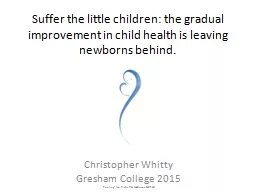PPT-Suffer the little children: the gradual improvement in chil
Author : myesha-ticknor | Published Date : 2016-10-18
Christopher Whitty Gresham College 2015 Painting Ian Richie RA Madonna amp Child In Thomas Greshams day infancy was very perilous In London around one quarter
Presentation Embed Code
Download Presentation
Download Presentation The PPT/PDF document "Suffer the little children: the gradual ..." is the property of its rightful owner. Permission is granted to download and print the materials on this website for personal, non-commercial use only, and to display it on your personal computer provided you do not modify the materials and that you retain all copyright notices contained in the materials. By downloading content from our website, you accept the terms of this agreement.
Suffer the little children: the gradual improvement in chil: Transcript
Download Rules Of Document
"Suffer the little children: the gradual improvement in chil"The content belongs to its owner. You may download and print it for personal use, without modification, and keep all copyright notices. By downloading, you agree to these terms.
Related Documents














